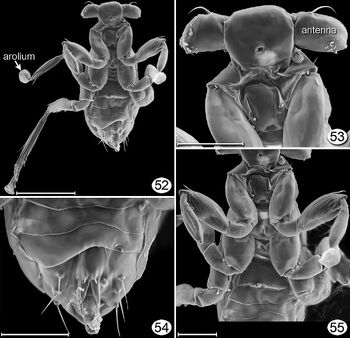(Created page) |
m (Cleaned up article) |
||
| Line 76: | Line 76: | ||
|Race = |
|Race = |
||
| − | |Status = |
+ | |Status = |
|Creator = |
|Creator = |
||
|First Sighting = 1997 |
|First Sighting = 1997 |
||
Revision as of 12:43, 27 June 2020
| Dicopomorpha echmepterygis | |||
|---|---|---|---|

| |||
| General information | |||
| Universe | Real Life | ||
| Classification | Dicopomorpha echmepterygis | ||
| Species type | Fairyfly | ||
| Homeworld | Earth | ||
| Environment | Illinois, United States | ||
| Intelligence | Non-sapient | ||
| Biochemistry | Carbon-based lifeform | ||
| Discovered | 1997 | ||
| Discoverer | Mockford | ||
| Biological information | |||
| Reproduction | Sexual; lays eggs | ||
| Average length | Female: 550 μm Male: 139 to 240 μm (Average: 186 μm) | ||
| Locomotion | Female: Powered flight Male: Hexapodal walking | ||
| Prey | Echmepteryx hageni eggs | ||
| Distinctive features | Smallest known insect | ||
| Lineage information | |||
| Related species | D. koreana, D. liaoningensis, D. macrocephala, D. maximus, D. pulchricornis, D. schleideni, D. stramineus, D. victoria, D. zebra | ||
| Cultural information | |||
| Alignment | True Neutral | ||
| Personality | Parasitic | ||
| Organization | Solitary (presumed) | ||
| Sociocultral characteristics | |||
| Scientific taxonomy | |||
| Planet | Earth | ||
| Domain | Eukaryota (Complex life) | ||
| Kingdom | Animalia (Animals) | ||
| Subkingdom | Eumetazoa | ||
| Infrakingdom | Bilateria | ||
| Superphylum | Ecdysozoa | ||
| Phylum | Arthropoda (Arthropods) | ||
| Subphylum | Hexapoda (Hexapods) | ||
| Class | Insecta (Insects) | ||
| Subclass | Pterygota (Winged insects) | ||
| Infraclass | Neoptera (Winged insects that can flex their wings over their abdomens) | ||
| Superorder | Hymenopterida | ||
| Order | Hymenoptera (Ants, bees, sawflies, wasps) | ||
| Suborder | Apocrita (Ants, bees, wasps) | ||
| Infraorder | Proctotrupomorpha | ||
| Superfamily | Chalcidoidea (Chalcid Wasps) | ||
| Family | Mymaridae (Fairyflies) | ||
| Genus | Dicopomorpha | ||
| Species | echmepterygis | ||
| Other information | |||
| First sighting | 1997 | ||
| Last sighting | Current | ||
Dicopomorpha echmepterygis is a species of fairyfly found in Illinois, United States. As of 2020, it is the smallest known insect species.
Physiology
D. echmepterygis are a species of parasitoid idiobiont that exhibit strong sexual dimorphism. Females have an average boy length of 550 μm, but males only have a length 40% of the females, instead having a body length between 139 to 240 μm, averaging 186 μm. Males are in fact smaller than certain species of single-celled amoebas and paramecia. Males are blind and wingless, and never leave the egg, which are laid on the eggs of the barklouse Echmepteryx hageni. Each egg contains at least one male and one female, though around 1/5th have a 3:1 male/female ratio.
This action is similar to other members of the chalcid wasps like Prestwichia aquatica.